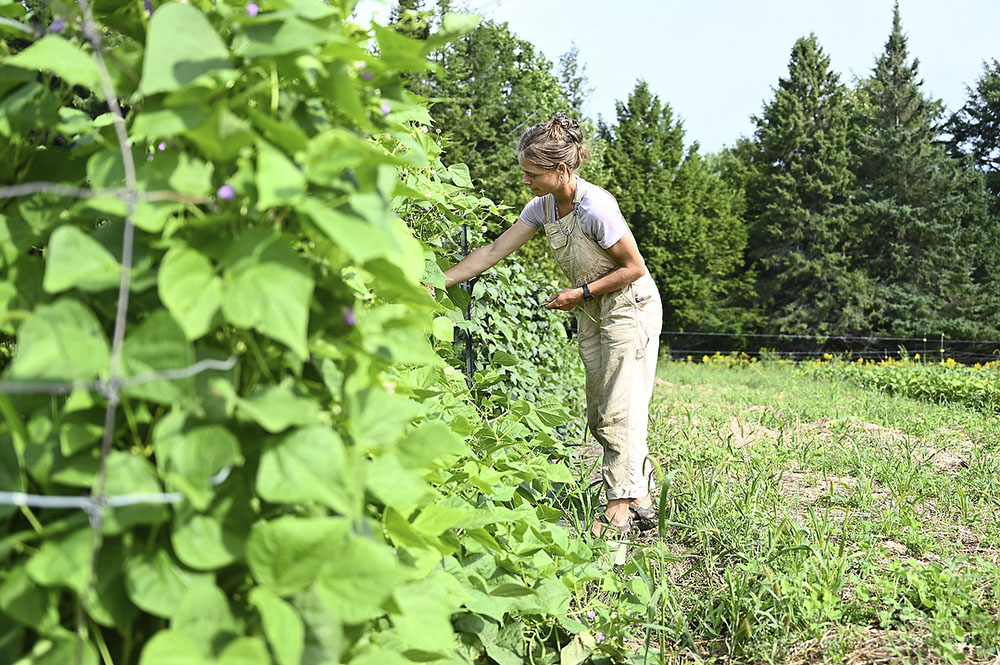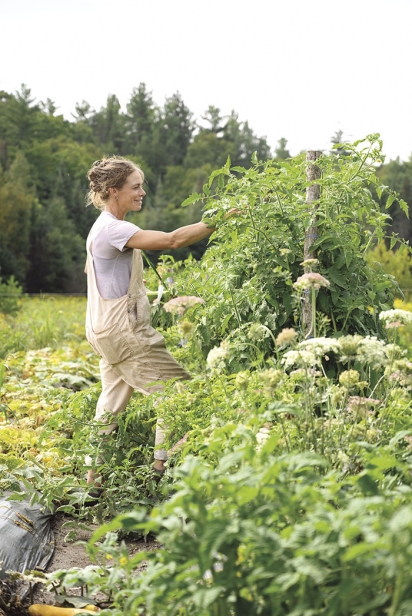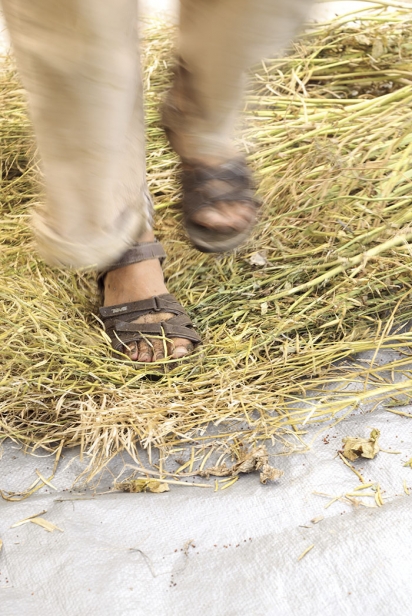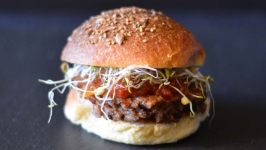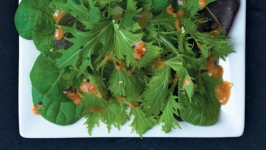The Seed Farmer
On a sunny but chilly mid-September day, there’s the threat of an early frost in the forecast and Catherine June Wallenburg is resigned. It’s just one more thing that nature has thrown at her in 2020.
As if COVID-19 wasn’t enough, the farming season has been a tough one that began with a drought and extreme heat days, then offered biblical rains in August, followed by early frost.
Wallenburg shrugs. “There’s nothing I can do about it,” she says, surveying her acres of garden on a country road in Farrellton, Que. “The hardier plants will survive, such as beet and kale and probably squash for a while as the leaves protect the fruit from the first frost, but the really tender plants, such as tomatoes and corn will not.” And that’s a short lesson in survival as a small- scale farmer. You have to learn to go with what nature offers.
This is one of the pillars of Wallenburg’s business, Northern Seeds. Growing things is not just about adversity and an unequal struggle with nature. It’s not just about what you can get out of the ground, but how you work with and contribute to the complete cycle. “We feel reverence in our work,” she writes on her website. “Our growing practices reflect a profound respect for the natural world. We strive to improve soil health, foster biodiversity and maintain natural resources.”
Wallenburg moved to her 106-acre farm in 2017, however 2020 was her first season on the farm full time. She now cultivates 1.3 acres on a rotational basis with a further three acres planted with cover crop. This land is spread across three isolated fields, because while it might appear that she’s growing vegetables, she is in reality cultivating seeds. And some of these plants must not cross-pollinate. This is more complicated than it sounds. With animals, it’s as simple as keeping them apart with a good strong fence, but with plants, there are so many uncontrollable forces at play: Wind can transport pollen over distance, and then there are insects, not known for their trainability.
While avoiding cross-pollination seems hit-and-miss at first glance, it is, in fact, rather rigorously scientific. The seeds in your packet must reliably produce the variety listed, and Wallenburg has tested them all for traits that will ensure they flourish in our northern climate and taste great. This means that for any new product she sells, it takes several years to come to market. First, she must see how the plant grows and how it tastes over more than one season, before cultivating it for seed thereafter. “We strive to provide seed of the utmost quality — high germination- rate standard and vigour. And we carefully select varieties that are well adapted to short seasons and adverse conditions,” she says.
In 2020, there were plenty of adverse conditions. “It’s been really hard for organic farmers in the area because we keep breaking records and there have been plenty of pests. Rather than be constantly disappointed, it’s better to anticipate that nature will get its 20 per cent. There are squirrels, racoons, deer, groundhogs and bears, as well as bugs. One year, I harvested my peas and every single one was empty, taken by the red squirrel.”
A seed-grower is born
Wallenburg grew up in urban Montreal. It wasn’t until she was at university and visited Twin Oaks Intentional Community in Virginia that she had her first exposure to farming. This led her to homesteading in Missouri, before returning to Canada, where she helped found Beetbox Co-operative Farm in the Ottawa greenbelt. After a stint at Ferme Lève-tôt, an organic market garden in Low, just around the corner and down the dusty side roads of rural Quebec, she took the plunge to launch Northern Seeds.
Now, she grows more than 70 varieties of vegetable and flower seeds, as well as raising a few Red Angus beef cattle annually. During the summer of 2020, she grafted 26 apple trees and awaits delivery of seven plum, 11 more apple and a pair of pear trees. She will also be adding 10 saskatoon berry and 10 currant bushes. Clearly, growing things is in her blood. “There is something wonderfully magical about seeing a seed develop into a plant and then into delicious, abundant food. There are stories too, to the varieties and where they come from.”
As for harvesting, it’s all done by hand, although there are two pieces of machinery parked in the barn. The first is a 1948 Farmall Cub tractor. This striking red vintage workhorse is the best thing for tilling the rows due to its offset engine. The operator can look down at the row being worked, which makes it extremely precise. The other is a seed cleaner, but even that is quite low tech, Wallenburg says. “It’s two screens and a fan, powered by a little electric motor, almost exactly the same design as was used 110 years ago and still manufactured by the same company.”
Wallenburg picks the fruit, vegetable or flowers, and then harvests the seeds in many different ways. She harvests tomatoes into five-gallon buckets. She smashes cherry tomatoes with a two-by- four and she cross-sections bigger tomatoes to expose the seed cavities. Then she squeezes the juice and seeds into a bucket. The seeds ferment for between three and seven days, depending on the ambient temperature. She stirs the smelly goop at least once a day. During that process, the good seeds settle to the bottom of the bucket and the viscous seed coat (which inhibits germination) disintegrates. The fermenting also helps eliminate fungal and bacterial pathogens that might otherwise be seed-
propagated. Finally, she fills the bucket with water, lets the seed settle for a few seconds and then pours off the excess water with bits of tomato flesh in suspension. Doing this two to five times usually nets a clean seed lot that Wallenburg then spreads onto homemade screens to dry.
For cucumbers, the process is slightly different. The fruit becomes deep orange or yellow when mature for seed and its skin gets tough and thick. Wallenburg cuts it lengthwise and scoops out the seeds into a large bucket. There is usually no need to ferment the cucumber seeds, but she does still need to submerge them. The immature seed will float and much of the debris will stay in suspension and can be poured off with the excess water, much like the last step in cleaning the tomato seeds. Next, she might also use gold panning sieves if there are big heavy fleshy bits of debris that sink with the seed. After this step, she spreads the good seed on a screen to dry. “For all cucurbits, I will also winnow to separate out very light seeds, which are immature,” she explains, “as otherwise a few always get through.”
Flowers are more tricky, she says. “Sometimes, I just can’t find the seed on the plant; that’s the case with statice. There are no books or online resources that I have found that document how to extract statice seed, and none of my seed-growing friends nor mentors has tried or been successful in doing so. I’m not even sure if the statice I grow has time to mature seed, I might be looking for something that just isn’t there,” but others, such as sunflowers are simple.
Zinnias are a little more typical. It’s easy enough to identify the seed, but only five per cent of Zinnia seed is mature and it’s very hard to separate mature from immature seed and debris because the seed is flaky. “Many flower seeds are light and oddly shaped,” Wallenburg explains, “which makes them hard to separate by screening and winnowing.”
At the end of a successful harvest Wallenburg is left with tens of thousands of tiny seeds to put into envelopes. “It’s like packaging gunpowder,” she says. “It can take days just to pack up all the tomatoes.”
Northern Seeds
657 Chemin Pritchard, Farrellton, Que.
northernseeds.ca | 514.834.1686 | @northernseeds.ca


